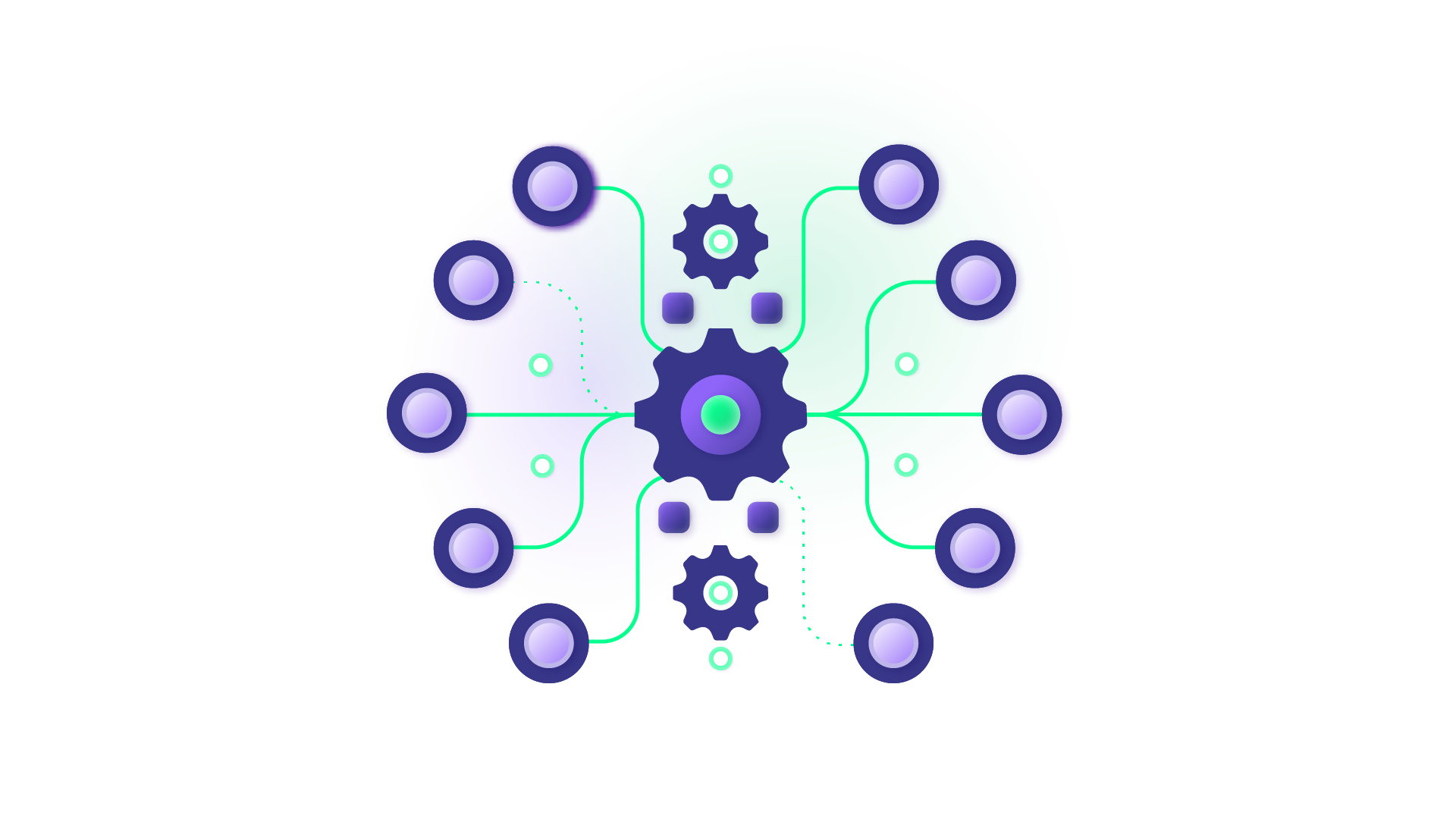The concept of system integration and automation has become a serious consideration for businesses, particularly in terms of connectivity and digital transformation.
Although both concepts are different, data integration and automation focus on keeping applications, and by extension, teams connected so they can create seamless workflows.
To properly dissect integration and automation from a business perspective, read on as we explore examples and use cases for both concepts.
What is Integration?
Integration is the process of connecting two or more applications, services, teams, and hardware solutions in order to get them to interact and exchange information.
As a company with several applications within your SaaS sprawl, integration is the only way to bridge the compatibility and interoperability gap between all these systems.
So it goes something like this:
You have a Jira Cloud instance used by your developers, and you need to integrate it with the Zendesk instance used by your customer support team.
Now, since both systems have different data formats and API configurations, only a native or third-party middleware can do all the transformation, conversion, and much more.
Types of Integration
Integration can fall into any of these types:
- System integration: You get to sync disparate hardware or software systems. For instance, you could sync a CRM (customer relationship management) with an ERP (enterprise resource planning). Or you could connect multiple tickets to a single online dashboard application.
- Data integration: When you integrate systems, the primary focus is to shuffle data back and forth between them. Companies can set up bi-directional or unidirectional integration of sensitive business and customer data in accordance with compliance regulations.
- B2B Integration: Connecting multiple businesses provides a platform for connectivity between MSPs, vendors, suppliers, retailers, and outsourcing partners.
- Application integration: This focuses specifically on syncing applications (software) such as Jira, Shopify, WooCommerce, Teams, GitHub, Salesforce, and much more.
- Legacy system integration: When you connect two legacy systems or one legacy system with modern SaaS applications, you extend the functionality without incurring the cost of modernization.
- Process integration: This involves unifying cross-functional workflows between teams or companies. So, one process is directly tied to another. For instance, you can link customer support directly to service delivery.
- EAI (enterprise application integration): As the name suggests, this involves connecting enterprise applications to streamline operations such as payroll, human resources, finance, and sales.

Explore how Qualco used process automation and integration to speed up incident resolution time and reduce unnecessary chatter.
What is Automation?
Automation is the process of replacing manual tasks with automatic processes powered by technology or robots. On a base level, automation involves limiting human intervention where possible in day-to-day business processes.
Imagine this automation scenario:
You want your help desk application to sort the incoming tickets based on labels. Any ticket labeled “Software” goes to Jira, while any ticket labeled “hardware” goes to Azure DevOps.
This is one application of automation in a customer support ecosystem.
Types of Automation
Automation comes in any of these forms:
- IT process automation: Routing tickets automatically from ServiceNow to Jira Service Management is a form of automation that is integral to the ITSM framework of most companies.
- Business process automation (BPA): You can automate business processes such as document generation and approvals instead of spending time on email back-and-forth.
- Robotic Process Automation (RPA): Repetitive tasks and processes like data entry, OCR data extraction, and balancing of accounts can be handled with robotic automation. The humans will become more productive, and less time will be spent on redundant tasks.
- Test automation: QA teams can automate software testing procedures by setting up unit tests to run whenever changes are made to the code base.
- Marketing automation: This is a variation of business process automation that focuses solely on repetitive marketing tasks such as making social media posts and generating RFP for new opportunities.
Integration vs Automation: Main Similarities and Differences
Although integration and automation are used interchangeably these days, both terms are significantly different in a lot of ways.
But first, let me show you how they are similar.
The main goal of system integration and automation is to reduce manual work and improve the efficiency of business processes. You can integrate and automate both hardware and software solutions within your workflow.
Also, automation often requires active integration between applications or organizations. Integration also relies on automation to work correctly, which explains the prevalence of automated integration solutions like Exalate.
That’s as far as the similarities go.
So, what is automation and integration in the context of internal and external collaborations?
While integration focuses on communication between systems and data exchange, automation focuses on the execution of tasks and completion of processes.
Automation relies on scripts, triggers, and workflows, while integration works with the help of APIs, webhooks, and ETL (extract, transform, load) frameworks.
Let’s use an example to highlight the difference between automation and integration.
When you connect Jira with Salesforce to share data, that’s integration. But when a Salesforce opportunity triggers the creation of a Jira ticket, that’s automation.
Essentially, integration often requires automation to function correctly. But automation can work independently of integration.
| Integration | Automation | |
| Definition | It is the process of connecting different systems or applications to share and exchange data. | It is the practice of using bots and other tools to perform tasks without human intervention. |
| Main goal | To enable disparate systems to communicate and establish a seamless collaborative environment | To increase the efficiency of repetitive, large-volume tasks by offloading the complexity to technology |
| Tools | APIs, ETL, webhooks, triggers. | Bots, scripts, triggers, workflows. |
What is Automated Integration?
Automated integration is the process of connecting systems so that they can interact and carry out operations independently with little to no human intervention.
As mentioned earlier, automated integration is what you get if automation and integration had a baby.
To automate integrations, you need a trigger (event-based or time-based). This trigger usually contains a set of conditions instructing the automation what to do when specific things happen within a certain period.
You can also set up the automated integration to run in real-time or near real-time, depending on the urgency.
Financial institutions automate integrated systems in order to help them balance and reconcile transactions. That’s why you receive payment notifications instantly; then you might see a reversal notification later in the day.
Automated integration also applies to every type of integration, including EAI, B2B, and A2A (application-to-application). It also involves connecting different devices and sensors to automate data collection and transfer.
Exalate offers software integration and automation services for the bidirectional connection of systems in order to get them to share data securely.
Exalate has a perfect blend of automation and integration in the sense that it allows the use of an AI-powered scripting engine to generate sync rules. You can also control the sync using event-based triggers.
What are Some Examples and Use Cases for Integration and Automation?
Let’s go through some business automation and integration use cases for companies and enterprises.
#1 – Connect your CRM with Help Desk Applications
Companies rely on CRM and marketing automation integration to connect help desk applications with other platforms.
When a customer creates a case in Salesforce, their account and contact information will be replicated in a Freshdesk, Jira Service Management, or Zendesk ticket.
Essential data such as attachments, SLA, comments, status, priority, and custom field values will all be transferred to the help desk for better visibility and added context.
#2 – Improve Customer Support
Your team can improve the resolution speed and customer satisfaction by revamping the entire customer service process and automating certain aspects of it.
With self-service portals and AI-enabled support services, customers can tap into the knowledge base in ServiceNow to get solutions to simple issues.
These exact integration and automation services could be applied to password resets and account recovery without having a human oversee the process.

Read a Complete Timeline of How Turkey’s Biggest Insurance Company Uses Exalate to Promote Real-Time and Seamless Synchronization with Suppliers.
#3 – Smoothen the Sales Pipeline
When an opportunity in Salesforce decides to go ahead with the deal, any single change in the status will create a work item, which will trigger the creation of a quote. The faster the process, the higher the likelihood of closing the deal
Similarly, you can update account information from a Jira custom field or sync multiple related Salesforce objects to a single Jira work item to make it the single source of truth.
#4 – Improve eCommerce and Retail
Another application of marketing automation and CRM integration in sales can be found in eCommerce. Once a customer places an order, the inventory will be updated automatically based on the available stock. The retailer will receive low-inventory notifications.
After that, the invoice will go straight to the proper channels for approval before the item goes out for shipping. Companies like LF Logistics use this type of integration and automation to streamline processes between their call center and support teams.
#5 – Speed Up Incident Response
Automation and integration in cybersecurity appear more frequently when a website is under attack or a frequently used feature is broken.
When a customer raises an incident, you want the details to get to the service team or engineers as soon as possible. This will help them figure out if it is a simple bug or whether your website is under attack.
A cybersecurity MSP was able to implement a ticket-based security incident management framework with clients and partners.

We have had an excellent customer experience with Exalate. They are always responsive and ready to resolve any problems we or our customers might face.
— Alexander Sinno, NVISO
What are the Benefits of Integration and Automation?
Here are the reasons why companies around the world believe that automation and systems integration tools like Exalate are the way to go for better business outcomes:
To Save Time
The main benefit of workflow automation and integration is that it allows real-time or near-real-time information exchange.
So what does this mean for your business?
This ensures that any side of the integration will get the information they need in a timely manner without making manual requests and going through administrative hurdles.
Not only that, you’ll also be able to make well-informed business decisions on the fly because you have all the context about updates and delivery statuses.
To Improve Productivity
Modern CRM integration and automation tools prioritize real-time data sync, which makes workflows more productive and processes more efficient.
So instead of spending time manually generating invoices for every purchase, you can plug into a document generation system like PandaDoc to automate the process.
These automation and integration services will increase the completion rate for invoice generation.
To Improve Communication and Transparency
When companies operate in silos, the lack of transparency and open communication will slow things down to bureaucratic snail pace.
With business integration and automation, companies can share vital information quickly and easily, rather than relying on emails and spreadsheets.
Any team member or company within the value chain will receive instant updates and access to vital communication in real time on a single platform.
To Save Costs
Integrating and automating systems can help you reduce intended and unintended costs.
Intended or planned expenses include subscription and licensing fees, which can be avoided by integrating another organization’s system instead of onboarding a whole new application for a single purpose.
Unintended expenses include the cost of human error and data duplication. If an overworked sales official generates the wrong invoice or quote, this could lead to serious costs for your business.
A software development company in Poland used AI and automation integration to connect their Jira Service Management instance between the DevOps team and the Growth team. This helped them spend less on agents while scaling operations faster.

I was positively surprised by how Exalate satisfied our synchronization needs. We even managed to reduce the monthly costs of Growth’s Service Desk by around 95%.
— Piotr Radtke, Senior Project Manager at Netguru
To Reduce Human Error
The main goal of automation and technology integration is to reduce human involvement and the inevitable errors that come with it.
This is not to say that automated tools are not error-prone. But once you get the configuration formula right, you can rest assured that the automation will provide consistent results. You will also be able to avoid duplicates and omissions.
Imagine your team wants to consolidate task-level data and create unified dashboards and reports in one of the integrated systems. The quality of this report can only be trusted if you can automate the recovery and analysis process.
What are Automation and Integration Tools?
Based on our previous definition of automation and integration, you need specific tools to make sure the connected systems or applications interact as intended.
Automation and integration tools can be in the form of custom scripts or applications developed for a specific purpose. The other option is to get a dedicated IPaaS integration and automation tool.
Here are some key features of any reliable integration and automation platform:
- Flow designer or scripting console: To help you visualize every connection and write sync rules.
- Triggers: To help you establish conditional logic and specify events for automated actions.
- Pre-built connectors: This template of integrations will help speed up the configuration of connections instead of starting everything from scratch.
- AI assistance: Tools like Exalate use an AI chatbot called AI Assist to help users generate scripts for integration, especially useful if you want to implement advanced use cases.
- Activity trail: To help system admins monitor user activity and find out where things went wrong.
Here are some automation and integration tools.
Zapier
Zapier provides no-code integration and automation solutions that allow you to connect applications using “Zaps” or event-triggered workflows.
Apart from Zaps, Zapier also supports Interfaces, Chatbots, and AI Agents for SMBs looking to connect different applications.
One major drawback to using Zapier is that it doesn’t allow custom scripts. So you are very limited in the use cases you can explore.
Exalate
Exalate provides custom integration and automation services via two connection modes. The Basic mode allows you to connect your systems using the no-code automatic integration option.
The Exalate Script mode is the main attraction here. It comes with a Groovy-based scripting engine that allows you to write scripts to control how the sync works.
The Script mode also comes with an embedded AI chat window (AI Assist), which allows users to convert their queries to scripts for mapping.
Triggers in Exalate also use platform-native query language to automate the integration of entities and fields based on specific actions and conditions.
Make (Integromat)
Make (formerly Integromat) is an AI integration and automation that uses visual-first automation to help system admins automate workflows and connect multiple applications using powerful AI agents.
With Make’s intuitive interface, teams can visualize automation systems, share workflows, collaborate on logic, iterate efficiently, and document processes clearly.
Workato
Workato’s leading automation and integration features come in the form of Actions and Triggers. The platform’s extensive use of AI in features such as Copilots and AI Workflows raises a cause for concern for those looking for good old scripting. Users can implement Workato for DevOps integration and automation.
Boomi
Boomi prides itself on automation and AI integration, with tools such as Boomi AI, Boomi Agent Studio, API management, and DataHub leading the charge.
Despite having a vast library of connectors, most of them are pre-built connectors with no wiggle room for customization.

Ready to learn more about iPaaS and third-party integration tools? Check out all the information you need about these solutions.
What are the Best Practices for Data Integration and Automation?
Based on our experience as seasoned integration service providers, here are the best practices and expert tips for data integration and automation.
- Make the objective of the integration clear. Specify if you want real-time insights, accurate reporting, or a better customer experience. This will help you tailor the sync properly.
- Consult with the other side. Schedule alignment meetings with the other team or organization to understand their needs as well as confirm what to map and what to keep private.
- Implement coherent data management strategies to avoid information duplicates, errors, and loss. This is important for highly regulated industries, especially for manufacturing automation and integration.
- Establish documentation to record everything, including strategies, field mappings, custom script snippets, trigger logic, etc. Don’t take anything for granted. Write down everything, even naming conventions.
- Use security features like audit trails, role-based access, API tokenization, and firewalls to keep your data protected at rest and in transit. Follow compliance standards, such as GDPR and SOC 2.
- Test every integration and automation first before implementing them across complex workflows.
- Review the performance of the automation or integration regularly to help you keep an eye on important metrics such as outages, uptime, error rates, and much more.
Using Exalate for System Integration and Automation
Exalate supports both automation and integration. In fact, it provides a perfect blend of both concepts into a single AI-powered solution.
With Exalate, you can save costs and improve the efficiency of your internal and external workflows. The good thing is that you will regain complete control over your systems as well.
Exalate covers a wide range of applications, from the integration and automation of manufacturing systems to the connection of sales platforms with CRMs.
Beginners can check out the Exalate Academy to learn the basics about installation. If you want to play around with scripting, we have a library of script helpers to get you started.
Most importantly, your data will stay secure while you are resting and in transit. Visit our Trust Center to find out how we handle security.
Always follow the best practices and tips to make sure that your AI and automation integration function as expected while keeping your data secure.
Ready to integrate your systems and automate your syncs? Book a discovery call with our engineers.
Recommended Reads:










